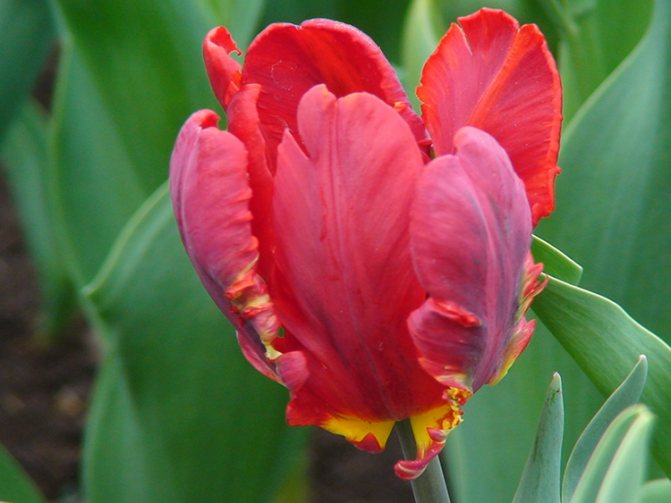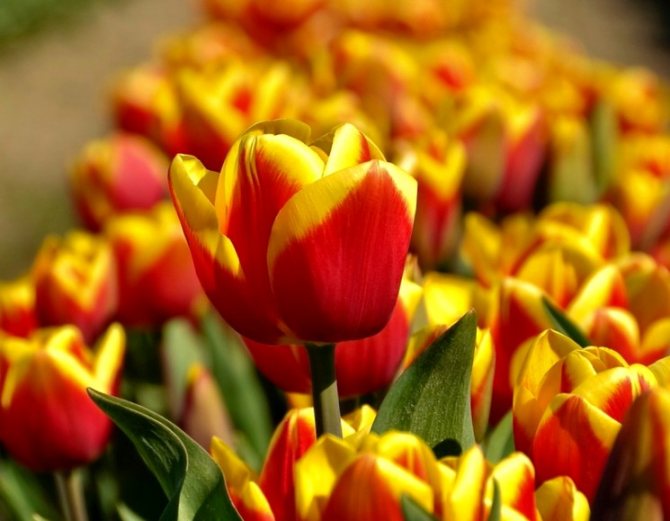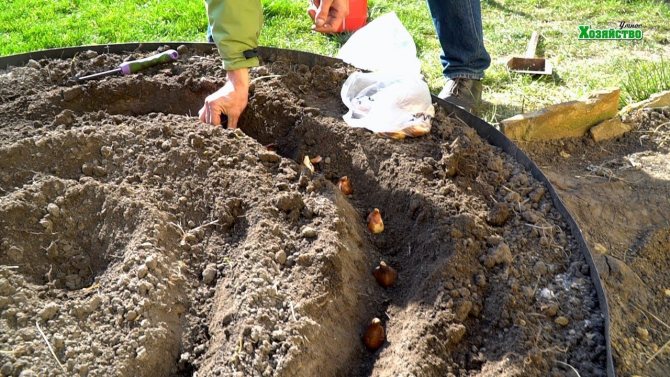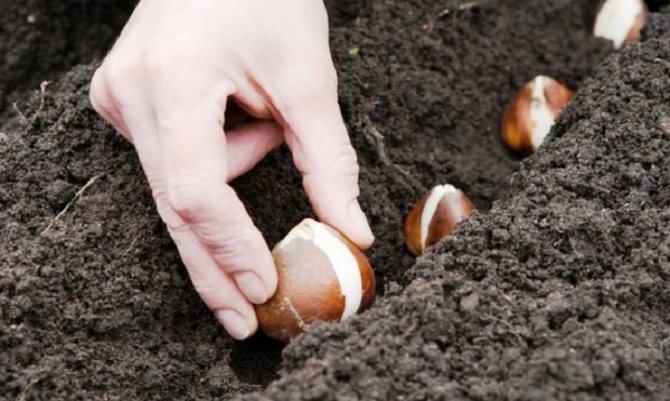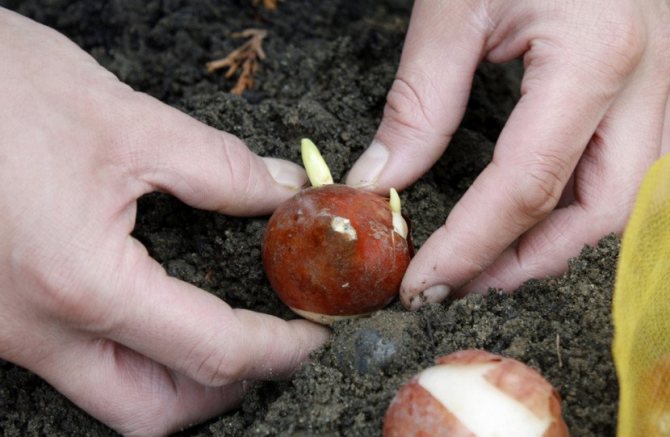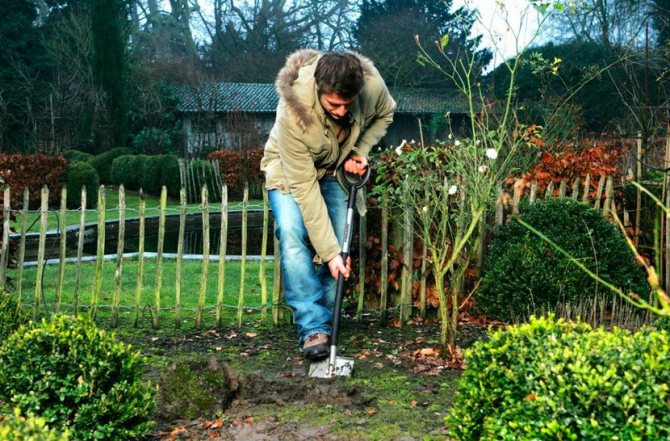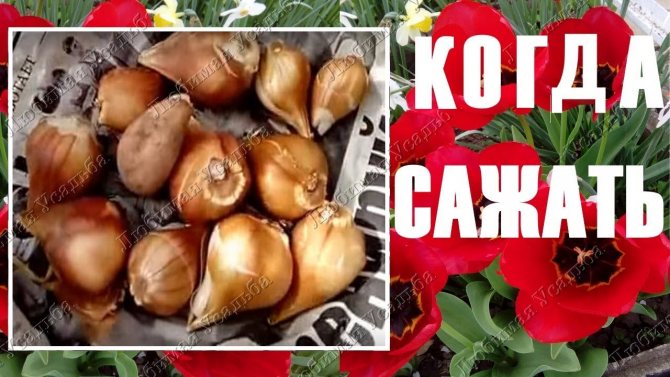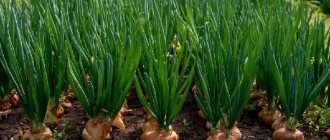Kind time of the day everyone.
Today we'll talk about the most popular spring flowers. And yes, of course these are magnificent tulips that amaze us with their diversity. They create a festive mood. And they always look good in the hands of children, girls, women. And also in flower beds.
Many people plant these flowers and I am no exception. Their variety of shapes and colors always surprises with their uniqueness. You can create amazing compositions from them. And they will delight us.
Although our pets are unpretentious plants. All the same, for their planting, it is necessary to prepare the soil, create conditions and care, if necessary, treat with protective agents.
To grow them, we need to be patient and surround them with care and love.
And only in this case they will respond and color the world around you with a rainbow color.
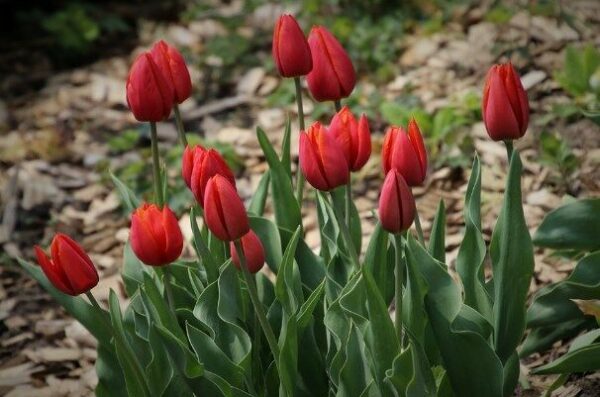
Why do they dig up tulips
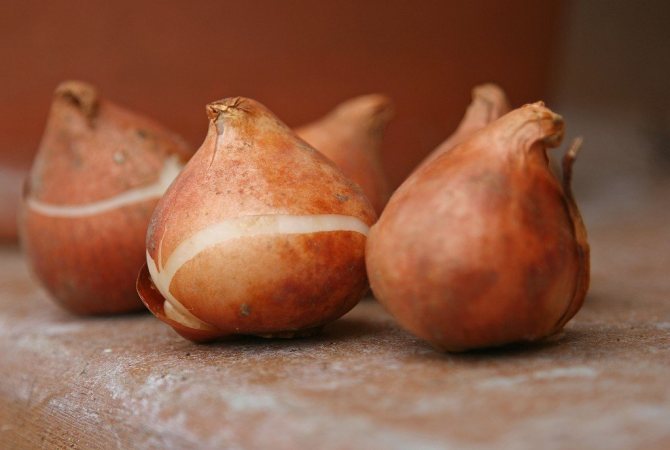

Tulip bulbs
Most novice flower growers do not suspect that decorative tulips need to be dug out after flowering. This is done for several reasons.
- To prevent the bulbs from sinking deeper into the ground. Because of this, tulips will bloom worse.
- To propagate tulips by dividing the bulb. In the process of development, shoots (“babies”) appear on the tubers of this flower. They can be used for breeding. If they are left on the mother bulb, then the tulip flowers will be smaller.
- Culling tubers. Sometimes tulip bulbs get sick. They can also be accidentally damaged when digging the soil. By digging them up, you can discard damaged tubers.
- Protection from pests. The soil is rich not only in nutrients, but also in numerous pests. To protect expensive tulip bulbs from insects and animals living in the ground, they are dug up after flowering.
IMPORTANT! New varieties and hybrids of tulips must be dug up at least once every 2 years.
Fertilizing tulips when planting, during the growing season, after flowering
Ordinary tulips are practically not whimsical. It is enough to add ash, humus or compost to the hole when planting.
But for varietal tulips, a more thorough inspection is needed. They need to be fed with mineral fertilizers 2-3 times per season.
The first feeding can be done even in the snow - scatter dry fertilizer - about 2 tablespoons per 1 sq. m.
The second top dressing is after the emergence of seedlings. The complete mineral fertilizer of Kemira Universal is best suited. Prepare the solution according to the instructions, water the tulip seedlings at the rate of 2-3 buckets of solution per 1 sq. m.
The third time I advise you to feed it after flowering, but no later than 2 weeks later. Dissolve 1 matchbox of any phosphate-potassium fertilizer in a bucket of water, such as potassium monophosphate. Pour the solution over the tulips that have lost their color.
How to store tulips before planting in the fall?
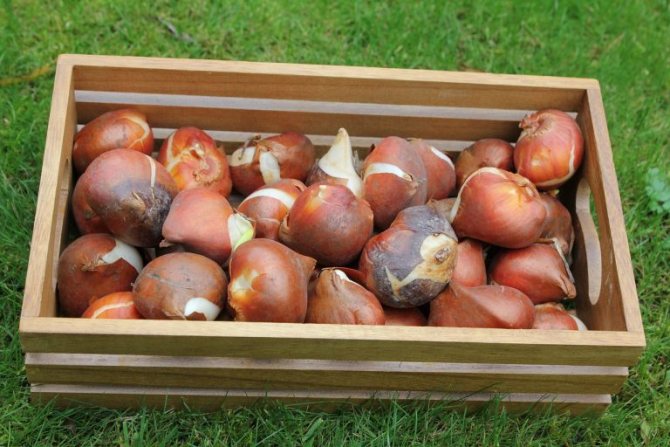

Storing bulbs in a wooden box
Having dug the tubers out of the ground, they need to be dried within 5-7 days. To do this, put them in a ventilated container (basket or box) and put them in a dry and warm place.
IMPORTANT! Do not allow direct sunlight to fall on the bulbs. Therefore, dry the tubers under a canopy.
When the tubers are completely dry, they must be cleaned of roots and scales. You also need to cut away rot and other damage. The place of the cut is necessarily lubricated with potassium permanganate.
Then the dug out and dried tulips must be treated with a fungicide to prevent possible diseases. Experienced florists advise using Fundazol.


Fundazol
The bulbs are now ready for storage. There are 4 main rules for storing tulip rhizomes:
- Stable temperature conditions. 25-27 degrees in the first 20-25 days, 15-20 degrees the rest of the time.
- Low humidity. Air humidity of 60-70% is optimal for storing tulip bulbs. If it is too dry, the tubers will begin to shrivel, and with high humidity, they will germinate ahead of time and begin to rot. If you are storing tulips in a damp room, place the tubers in sawdust. They absorb excess moisture.
- Lack of light. It is very important to store the bulbs in a dark place. In the light, they will begin to germinate ahead of time.
- Ventilation. If you do not provide free air access to the tubers, they will begin to rot.
Along with the lack of light, it is good ventilation of the premises that is the main condition for storing tulips. With unstable temperatures or high humidity, tubers can survive with proper care. If exposed to sunlight and there is no free access to air, the planting material will become unusable.
IMPORTANT! You need to store tubers in a wooden or plastic ventilated container. Bulbs should not be stored in plastic bags or buckets. If there are mice in the room, then it is better to put the tubers in nets and hang them from the ceiling.
Is it possible to plant tulip bulbs in spring
You already know that autumn is considered the best time to plant bulbs. But what if for some reason we did not manage to do it? Store the bulbs in the vegetable compartment in the refrigerator until spring.
I had this once ... True, a friend shook her head and said that her bulbs had rotted in the refrigerator (she kept them in a plastic bag). Taking into account her bad experience, I put the bulbs in a bag of thick paper. Periodically I looked there. But there were no rotten bulbs. There were several soft ones, I threw them away. Maybe later they would have rotted, I don't know. She didn't wait. I dropped it off at the end of February. I did not notice any special problems with flowering, with the timing of flowering. Bloomed at the same time as the neighbors.
So in February-March, the planted bulbs also take root well. Checked. When I call the timing of planting tulips - February-March, I mean, of course, Kuban. To the north, during these months, the soil is usually still covered with snow and there can be no talk of planting.
Florists from all regions should be aware that the daytime air temperature when planting tulips in spring should reach + 8-10 ° C.
When are tulips planted in autumn, what month and how to choose the time depending on the region?
The planting time of tulips depends largely on the climate of the region. The optimum soil temperature for planting is +10 degrees. The general guideline for the work is the Indian summer. But in warmer areas, planting can be done a little later.
Before the onset of frost, tulips must take root in order to survive the winter well. Therefore, in colder years, you need to start planting tubers earlier.
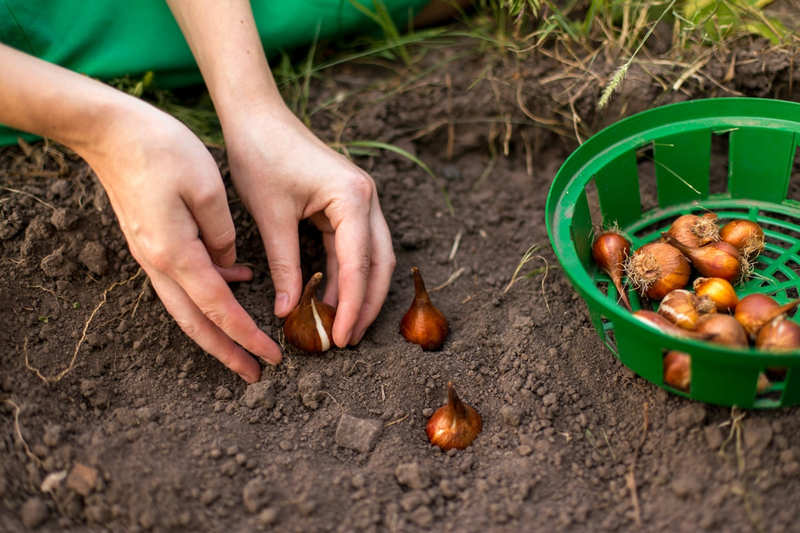

Planting tulips
Landing dates in the Middle Strip
In Central Russia and in the North-West of the country, tulips can be planted until October 20. But it is not worth delaying the work. It is best to plan your landing in the first half of the month so that you have time in reserve in case of rainy weather.
Landing time in the Urals
In the Urals, tulips should be planted in the tenths of September. In this case, it is best to additionally use a covering material: insulation, dry grass, moss, etc.
In outskirts of Moscow
In the Moscow region, tulips are planted throughout the first half of October.If the frost came too early, then it is better to postpone the planting of tubers in early spring, so as not to ruin the planting material.
In Belarus
Planting tulips in Belarus can be carried out at the same time as in Central Russia.
In Ukraine
In Ukraine, tubers are planted in late October - early November. But in Polesie, it is better to complete the work before the third decade of October.
Soil preparation
Before planting tulips in open ground, you need to properly prepare the soil. It is advisable to process it a week before planting flowers. The preparation is as follows:
- On the site for the proposed planting, you need to scatter mineral fertilizers. For this purpose, compost, suphosphate or humus are used. You can mix wood ash 200 g, potassium sulfate 40 g, ammonium nitrate 12 g and superphosphate 50 g.
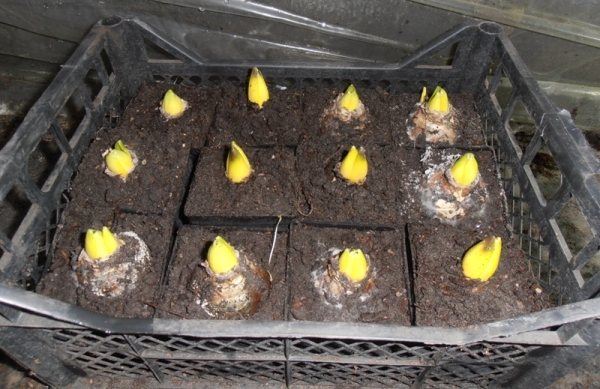

- After the fertilizers are distributed over the site, it is dug to the depth of the bayonet shovel. Then the beds are prepared here for planting tulips.
- In this state, the site should stand and sit down a little before planting begins.


Important: manure cannot be used as fertilizer. It can subsequently cause the bulbs to rot. That is, the flowers simply will not sprout in the spring.
Experienced summer residents and gardeners advise not to plant tulips in the same place for two or more years in a row. Also, you cannot plant flowers in those parts of the garden and vegetable garden where other types of bulbous plants previously grew. They all have similar diseases and are prone to attack by the same pests.
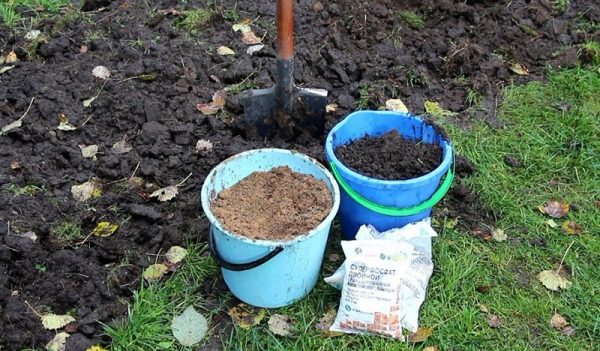

We prepare the planting material
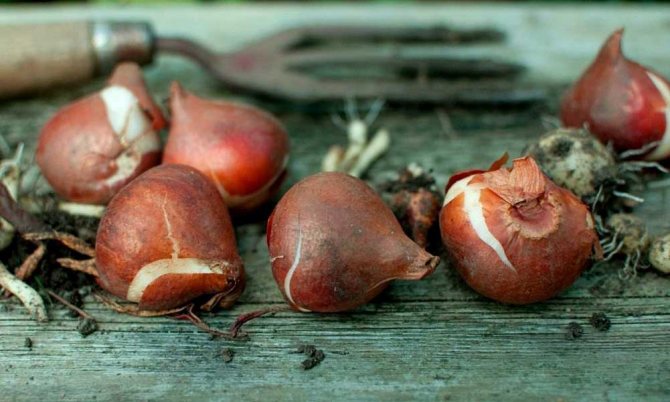

Tulip bulbs must be prepared for planting
Before planting the bulbs, it is necessary to carry out pre-planting preparation.
First of all, the tubers must be carefully examined for damage, rot and pests. To do this, you will have to remove the husk. If the damage to the bulb is insignificant, then after processing it can be planted in the ground along with the rest. Sick tubers are thrown away.
Next, you need to sort the tubers. Large ones are best planted separately, because their flowers will be larger.
After sorting, the bulbs are soaked in a solution of potassium permanganate or phytosporin for 40-60 minutes. Then the planting material is dried, avoiding direct sunlight.
The tulips are then ready for planting.
Primary care for planted tulips
After the tulips are planted in the soil, around the time of the first frost, you need to moisten the soil a little. Do not overdo it. But also do not allow the soil to dry out completely. Water the area about once every 4-5 days.
As the temperature drops, cover the tulip beds with withered foliage, humus, peat, or dry branches.


Tip: before planting tulips in the fall in open ground, carefully consider the color composition of the front garden, when the buds open and form a kind of rainbow.


Write in the comments: How do you deal with tulips in the fall?
How to plant outdoors in autumn?
Whichever method you choose to plant tulips, you still need to prepare the soil first.
Firstly, flowers are best planted in a lighted place. With a lack of light, tulips stretch out and become paler.
Secondly, the place of planting flowers must be protected from the wind.
Thirdly, tulips should be planted on a flat area so that there is no stagnant water.
Before planting, they dig up the ground under the tulips. Digging depth - 1 bayonet. Then the soil is fertilized. It is best to use a compound bulb fertilizer that is available at any hardware store.
The preparation of the soil must be carried out at least 30 days before the expected date of planting flowers.
Traditional way
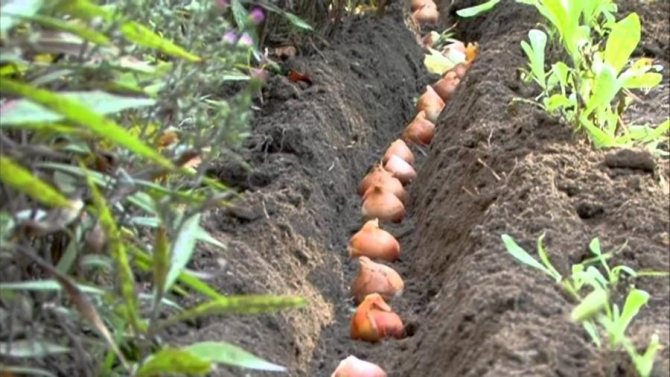

Planting tulips in the furrow
If you have pre-sorted the planting material, then planting the bulbs in the ground will not cause you any difficulties.
Tulips can be planted individually, in furrows and patterns. It all depends on the amount of planting material and your own imagination.
If you plant the bulbs in furrows, keep a distance of 25 - 30 cm between them. At the bottom of the furrows, you first need to pour a layer of sand (2 - 3 cm). Then spread the bulbs and cover them with nutrient mixture and soil.
IMPORTANT! Make sure that all tubers are laid out with the bottom down!
If the soil under the tulips is too dry, then it can be pre-watered with abundant water.
The distance at which you need to plant the tubers depends largely on the size of your plot. If you have extra space, then you can dig holes less often, at a distance of 15 - 20 cm.If you are limited in free space, then try to keep at least 8-10 cm between the holes.
After planting tulips, it is recommended to cover with 2 cm of peat or humus mulch.
In baskets
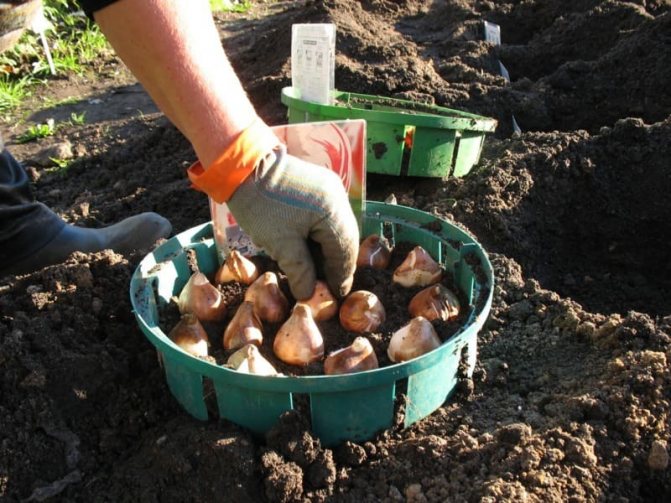

Planting tulips in a "basket"
Planting tulips in baskets has several advantages:
- You do not need to dig up the entire area in search of bulbs. They are all already in one place.
- Protection from insects and rodents that cannot get to the tubers.
- Each variety can be planted in a separate basket.
This method has only one drawback. If one bulb falls ill, then the others will also be doomed.
As a container for planting, you can use not only baskets, but also any other boxes, bottoms from plastic bottles, cake lids, etc. The main condition is the presence of ventilation holes.
By the way, recently special plastic boxes for planting bulbous crops have been sold in stores.
Prepare planting holes for the diameter and height of the "baskets". Pour 2-3 cm of sand at the bottom of the basket and lay out the onions. Then fill them with nutrient mixture. Ordinary soil can also be used.
Once the tulips are planted in the baskets, place them in the planting holes and straighten them to hide the edges of the baskets.
When the tulips bloom in the spring, you will dig containers and plant other flowers in this place.
Planting and care technology
In order for the plants to be healthy and enjoy abundant flowering, you need to follow the exact instructions for growing these flowers.
Important! Tulips react extremely poorly to stagnant melt water, so they should not be planted in lowlands and on flower beds with high borders, where there is no drainage of excess moisture.
First of all, you need to decide on the place where to plant tulips. They do well in the beds where vegetable and flower crops were their predecessors, with the exception of representatives of the Solanaceous and bulbous family. Due to the fact that the flowering of tulips is lush, but rather short, they often coexist in flower beds with perennials, whose growing season begins later than that of spring flowers.
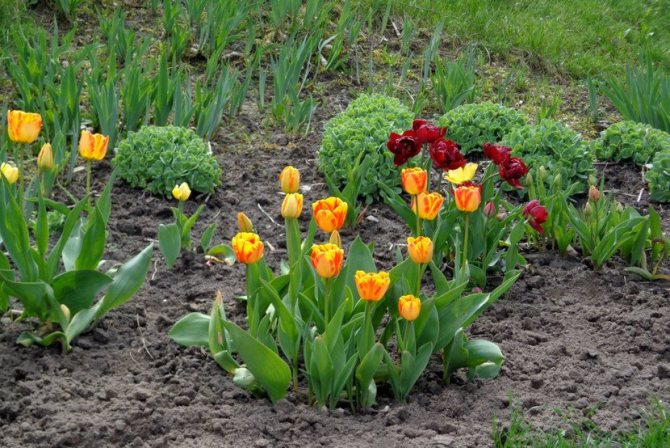

Soil preparation
After the desired tulip site is selected, the soil should be prepared for planting the bulbs. These flowers prefer loose, fertile soil with good drainage and neutral acidity. Tulips grow poorly, rot and die on clay soils with stagnant moisture. In order to increase the fertility of the land, two weeks before planting the bulbs, top dressing is carried out. For this, organic fertilizer is applied to the soil.
We recommend that you find out how to plant tulips beautifully and in an original way.
The rate for 1 m³ of soil is:
- compost or rotted manure: 5 kg;
- low-lying peat: 3 kg;
- nitrophoska: 50 g.
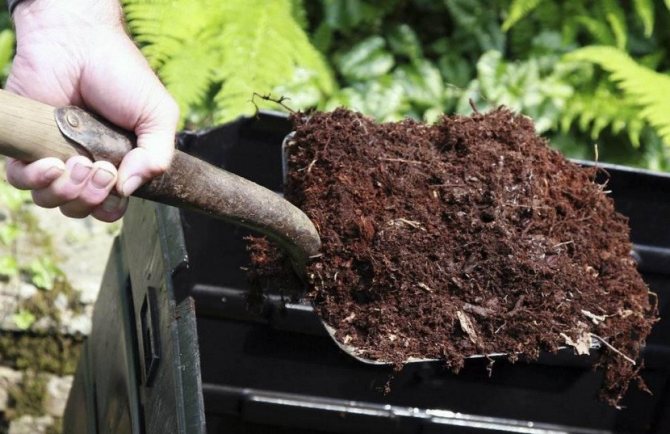

If necessary, the composition of the earth can be - to make the clay soil looser, you need to add about 7 kg of coarse sand or perlite to it. Slaked lime, introduced in a proportion of 200 g per 1 m³, will help to reduce the acidity of the soil.The day before planting the bulbs in the ground, you need to dig up the area and loosen the soil without leaving large clods. Immediately before planting, the ground should be disinfected by watering with a weak solution of potassium permanganate.
Did you know? The buds of the largest tulip variety Temple of Beauty reach a height of 14 cm, while the plant itself grows up to 1 m in height.
Preparing the bulbs for planting
Not only the soil needs preparation, the planting material should also be processed. To do this, the bulbs are carefully examined for rotting and the development of diseases. Poor-quality planting material is best destroyed, but not too damaged can be saved by cutting off the diseased area and sprinkling it with ash. This is usually done to preserve the rare bulbs.
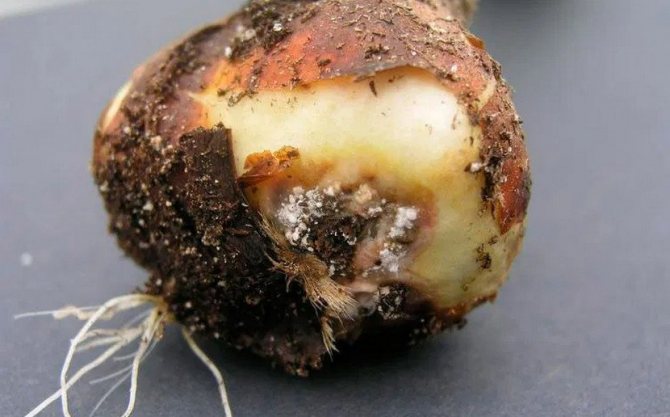

After that, the bulbs are cleaned of brown scales, leaving only the ones that are as close to the bulb as possible. These scales should not be removed, since they protect the tuber from the effects of external factors and pathogens. Immediately before planting, the bulbs are treated with a 2% solution of "Fundazol". The planting material is immersed in a liquid for 30–40 minutes, after which it is left to dry, after which it is planted in the ground.
How deep should the bulbs be placed before winter?
Tulips don't need to be planted too deep or they won't germinate in spring. Planting depth depends on the size of the bulb.
- Large bulbs are sown to a depth of 12-15 cm.
- Medium bulbs - 10 to 12 cm deep.
- Small bulbs - 6 to 8 cm deep.
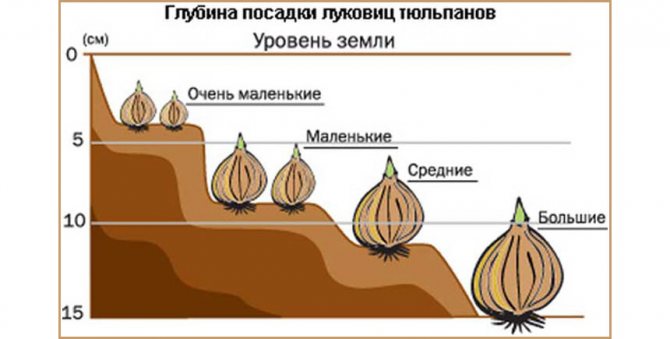

Planting depth of tulips
Please note that the smallest flowers will grow from the smallest tubers. Therefore, they need to be planted on the south side so that large flowers do not cover them from the sun.
REFERENCE. There is a way to determine how deep to bury the tubers. The depth of the hole should be 3 times the height of the tulip bulb.
Possible mistakes
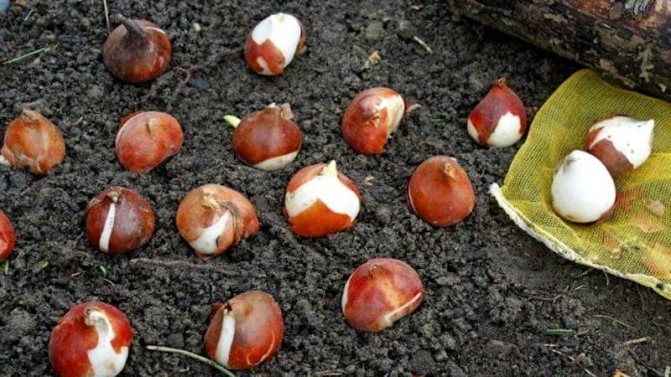

- Sloppy work. You need to be very careful when digging the bulbs out of the soil so as not to damage them. Any cuts threaten the roots with pathogens. If you accidentally damage the tuber, rinse it and treat it with potassium permanganate.
- Light in the room where the bulbs are stored. Many gardeners do not take into account the fact that sunlight stimulates the development of any plant. To prevent tulips from sprouting ahead of time, they need to be stored in the dark.
- Storage in a plastic bag or bucket. To prevent the tubers from rotting, they definitely need air. Therefore, store tulips in well-ventilated baskets, boxes or boxes. Storage in nets is also allowed.
- Too dry or too humid room. The optimum humidity for storing tubers is 60%. If it is not possible to provide it, then in the room it is necessary either to put containers with water or, conversely, to sprinkle the tubers with sawdust.
- Lack of preliminary preparation of the bulbs. Before you put the tubers for storage, they must be examined. Rotten roots are thrown away. If the bulb is slightly rotten, then the affected part can be cut off. But then you definitely need to process the cut with potassium permanganate.
- Planting too late or too early. If you plant the bulbs while it is still summer, the tulips will sprout and die from the frost. If they are late with the landing, then they will not be able to take root in the frozen ground.
- Failure to comply with the landing rules. Unprepared soil, improperly chosen planting depth, lack of fertilizers - all this negatively affects the rooting of the bulbs. And as a result, it directly affects whether your tulips will survive the winter.



